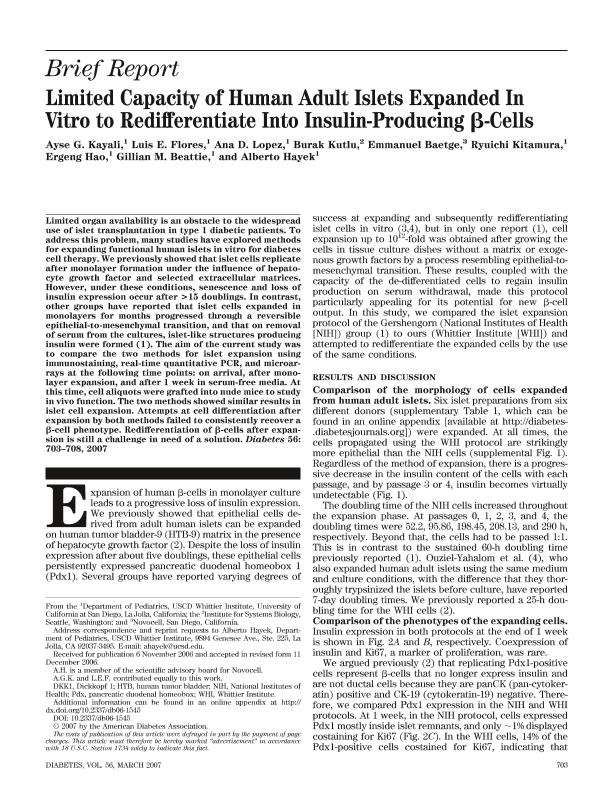Artículo
Limited Capacity of Human Adult Islets Expanded In Vitro to Redifferentiate Into Insulin-Producing β-cells
Kayali, Ayse G; Flores, Luis Emilio ; Lopez, Ana D.; Kutlu, Burak; Baetge, Emmanuel; Kitamura, Ryuichi; Hao, Ergeng; Beattie, Gillian M.; Hayek, Alberto
; Lopez, Ana D.; Kutlu, Burak; Baetge, Emmanuel; Kitamura, Ryuichi; Hao, Ergeng; Beattie, Gillian M.; Hayek, Alberto
 ; Lopez, Ana D.; Kutlu, Burak; Baetge, Emmanuel; Kitamura, Ryuichi; Hao, Ergeng; Beattie, Gillian M.; Hayek, Alberto
; Lopez, Ana D.; Kutlu, Burak; Baetge, Emmanuel; Kitamura, Ryuichi; Hao, Ergeng; Beattie, Gillian M.; Hayek, Alberto
Fecha de publicación:
03/2007
Editorial:
American Diabetes Association
Revista:
Diabetes
ISSN:
0012-1797
e-ISSN:
1939-327X
Idioma:
Inglés
Tipo de recurso:
Artículo publicado
Clasificación temática:
Resumen
Limited organ availability is an obstacle to the widespread use of islet transplantation in type 1 diabetic patients. To address this problem, many studies have explored methods for expanding functional human islets in vitro for diabetes cell therapy. We previously showed that islet cells replicate after monolayer formation under the influence of hepatocyte growth factor and selected extracellular matrices. However, under these conditions, senescence and loss of insulin expression occur after >15 doublings. In contrast, other groups have reported that islet cells expanded in monolayers for months progressed through a reversible epithelial-to-mesenchymal transition, and that on removal of serum from the cultures, islet-like structures producing insulin were formed (1). The aim of the current study was to compare the two methods for islet expansion using immunostaining, real-time quantitative PCR, and microarrays at the following time points: on arrival, after monolayer expansion, and after 1 week in serum-free media. At this time, cell aliquots were grafted into nude mice to study in vivo function. The two methods showed similar results in islet cell expansion. Attempts at cell differentiation after expansion by both methods failed to consistently recover a β-cell phenotype. Redifferentiation of β-cells after expansion is still a challenge in need of a solution.
Palabras clave:
ISLETS
,
REDIFFERETIATION
,
INSULIN PRODUCING CELLS
Archivos asociados
Licencia
Identificadores
Colecciones
Articulos(CENEXA)
Articulos de CENTRO DE ENDOCRINOLOGIA EXP.Y APLICADA (I)
Articulos de CENTRO DE ENDOCRINOLOGIA EXP.Y APLICADA (I)
Citación
Kayali, Ayse G; Flores, Luis Emilio; Lopez, Ana D.; Kutlu, Burak; Baetge, Emmanuel; et al.; Limited Capacity of Human Adult Islets Expanded In Vitro to Redifferentiate Into Insulin-Producing β-cells; American Diabetes Association; Diabetes; 56; 3; 3-2007; 703-708
Compartir
Altmétricas



